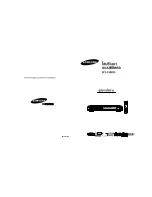
To avoid short-circuits between the charge lead, always connect the charge cable to the
unit first and only then to the batter to be charged or discharged. Reverse the sequence
when disconnecting.
Very Important!
Do not connect more than one battery pack to the charge lead at any one time.
The charger is not suitable for the following battery types
Battery pack, which consists of different types of cell (including different manufactures)
Battery which is already fully charged or just slightly discharged
Non-rechargeable batteries (Explosion hazard).
Batteries that require a different charge technique from NiCd, NiMH, Lilo, LiPo, LiFe or
Pb.
Faulty or damaged battery.
Battery fitted with an integral charge circuit or a protection circuit.
Batteries installed in a device, or which are electrically linked to other components.
Batteries that are not expressly stated by the manufacture to be suitable for the cur
rents the charger delivers during the charge process.
Please bear in mind of checking the following point before
charge operation:
Did you select the appropriate program, which are suitable for the type of battery?
Did you set up adequate current for charging or discharging?
Lithium battery pack can be composed with parallel and series circuits mixed. You have
to check the composition of the battery pack carefully before charging
Are all connections firm and safe, or is there an intermittent contact at any point in the
circuit?
Charging
A specific quantity of electrical energy is fed into the battery during charge process.
The charge quantity is calculated by multiplying charge current by charge time. The
maximum permissible charge current varies according to the battery types or its
performance, and can be found in the information provided by the battery manufacture.
It is only allowed to charge batteries at rates higher then the standard charge current if
they are expressly stated to be capable of quick-charge.
Connect the battery to charge to output terminal of the charger using suitable charge
Warning and safety notes
Warning and safety notes
08
09
Warning and safety notes
Lead. They are red, positive (+) and black, negative (-). Since the charger cannot detect
the difference between the internal resistances of the battery pack, cable resistance and
connector transfer resistance, the first requirement if the charger to work properly is that
the charge lead should be of adequate conductor cross-section. And also high-quality
connectors (normally gold-contact type) must be fitted to both ends. Refer to the
information provided by the battery manufacture regarding charging methods, and verify
the recommended charge current and charge time. Especially for Lithium batteries, you
have to follow the charge instruction provided by the manufacturer strictly.
Do not attempt to disassemble the battery pack arbitrarily.
You have to pay attention to verify the capacity and the voltage of the Lithium battery
pack. It may be composed of parallel and series connection mixed. In parallel link the
capacity of the battery pack is multiplied by the number of cells but the voltage remains
the same. That kind of voltage imbalance causes a fire or explosion during charge
process. We recommend you compose the Lithium batter pack in series only.
Discharge
The typical purpose of discharge is to determine the residual capacity of the battery, or to
lower the voltage of battery to a defined level. When you discharge the battery you also
have to pay attention on the process same as charging. To avoid the battery becoming
deep-charged, set the final discharge voltage correctly. Lithium batteries should not be
deep-charged to lower than the minimum voltage, as this leads to a rapid loss of capacity
or a total failure. Generally, you do not need to discharge Lithium battery voluntarily.
Some rechargeable batteries are said to have a memory effect. If they are partly used and
recharged before the whole charge is drawn out, they "remember" this and next time will
only use that part of their capacity. This is a 'memory effect' NiCd and NiMH batteries are
said to suffer from memory effect. They prefer complete cycles; fully charge then use until
empty, do not recharge before storage-allow them to self-discharge during storage. NiMH
batteries have less memory effect than NiCd. The Lithium battery prefers a partial rather
than a full discharge. Frequent full discharges should be avoided if possible. Instead,
charge the battery more often or use a larger battery.
The brand-new NiCd battery pack is partially useful with its capacity until it has been
subjected to 10 or more charge cycles in any case. The cyclic process of charge and
discharge will lead to optimize the capacity of battery pack.
Those warning and safely notes are particularly important.
Please follow the instructions for a maximum safely; otherwise
the charger and the battery can be damaged violently. And also
it can cause a fire to injure a human body or to lose the property.




































